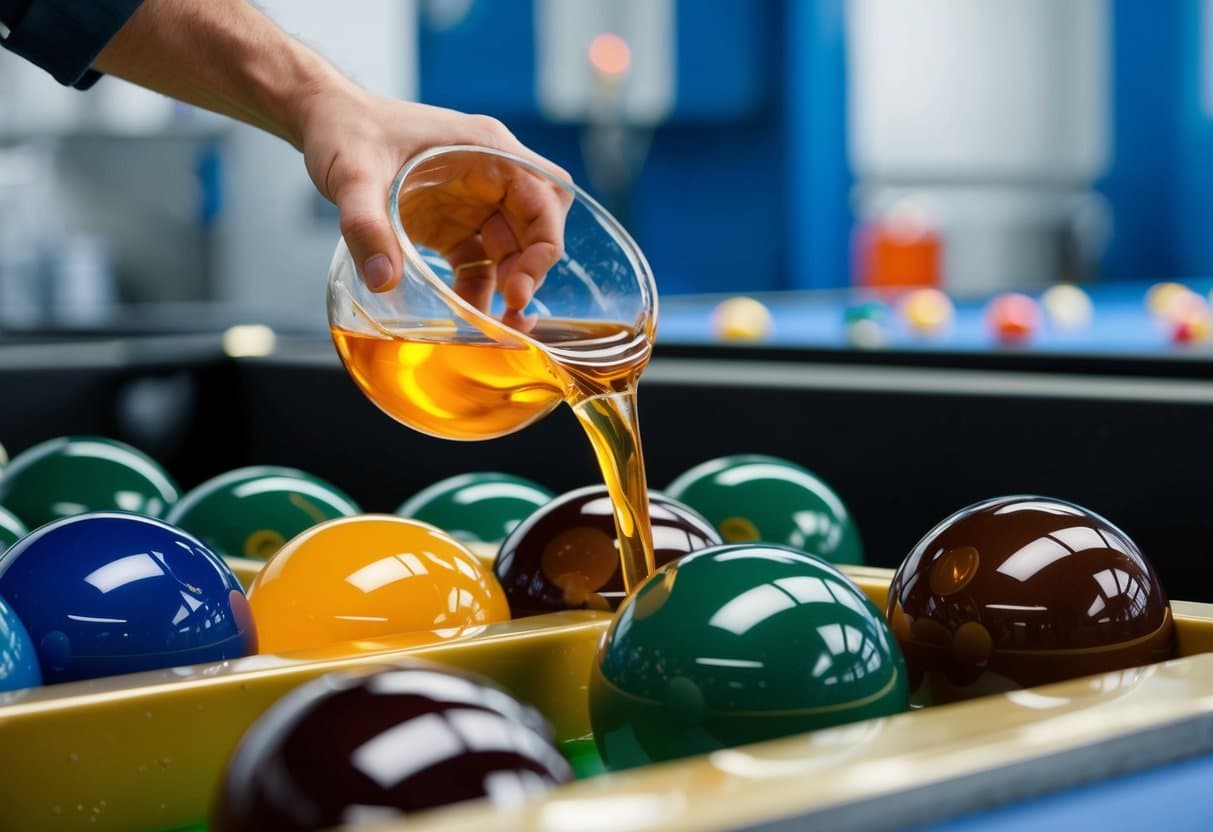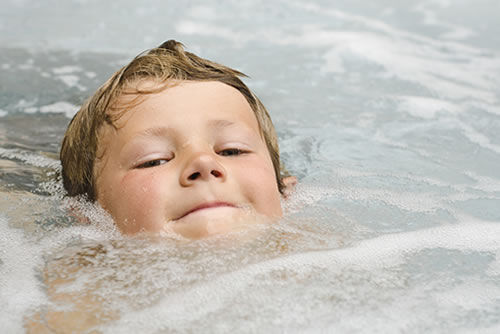Pool balls have come a long way since their early days. These small, round objects are essential for playing pool, snooker, and other cue sports. But what are pool balls made of? What are billiard balls made of? Are they the same thing?
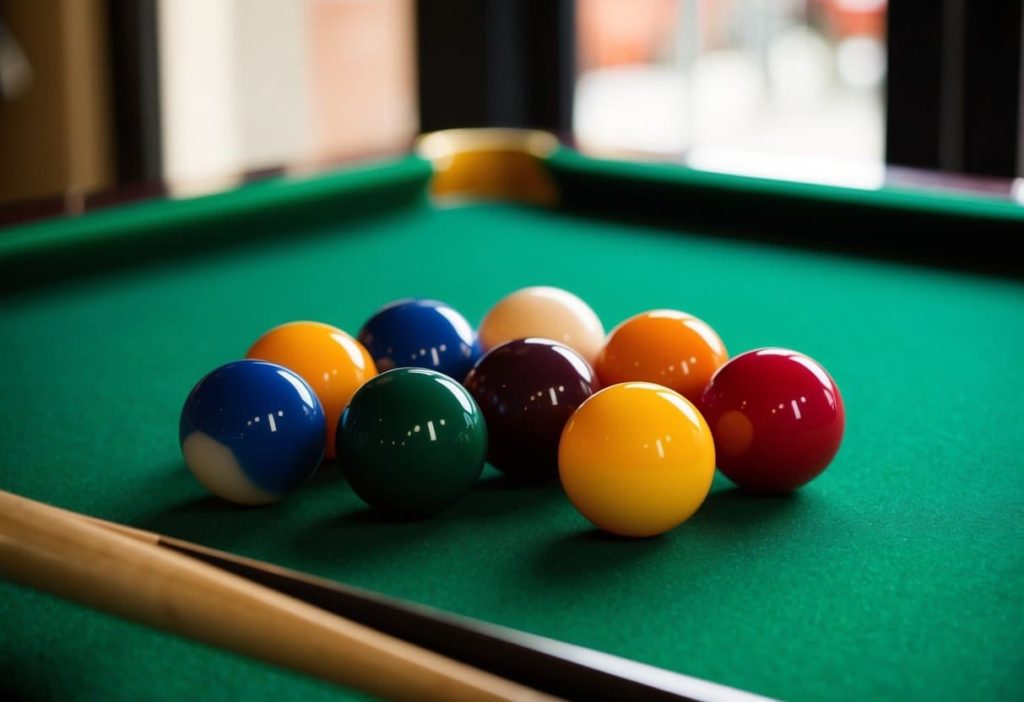
Modern billiard balls are typically made of synthetic plastic and phenolic resin. This substance offers excellent durability and consistency. It allows for precise manufacturing to meet strict size and weight standards.
Billiard balls have been made from different materials in the past. Ivory was once popular but is no longer used due to ethical concerns. Other materials like wood, clay, and celluloid have been tried over the years. Today’s phenolic resin balls provide players with reliable performance and long-lasting quality.
Historical Evolution of Billiard Balls
Billiard balls have changed a lot over time. In the early days, people made them from wood. These wooden balls weren’t very good and didn’t last long.
In the 1600s, ivory became the top choice for billiard balls. Ivory came from elephant tusks. It was smooth and heavy, perfect for the game. But getting ivory meant killing elephants, which was bad for elephant populations.
By the 1800s, ivory was getting harder to find. John Wesley Hyatt tried to make a new material to replace it. In 1869, he created celluloid. This was one of the first synthetic plastics.
Celluloid wasn’t perfect, though. It could catch fire easily and didn’t last as long as ivory. In 1907, Leo Baekeland made a new plastic called Bakelite. It worked better than celluloid for billiard balls.
Today, most billiard balls are made from phenolic resin. This material is strong, lasts a long time, and rolls smoothly. It’s also much cheaper than ivory and safer for elephants.
The switch from ivory to plastics was good for the game of billiards. It made balls more affordable and helped save elephants. Now, players can enjoy the game without harming animals.
Materials and Composition
Billiard balls have evolved from natural materials to advanced synthetic compounds. Their composition impacts performance, durability, and cost.
Ivory and Early Materials
Ivory was the top choice for billiard balls in the 19th century. It came from elephant tusks. Ivory balls were prized for their feel and sound. But they had problems. They cracked easily and were costly. Other natural materials like wood and clay were tried. None matched the ivory’s quality.
As elephant numbers dropped, makers looked for new options. This search led to the birth of plastic.
Introduction to Synthetic Materials
In 1869, John Wesley Hyatt created celluloid. It was the first synthetic plastic. Celluloid balls were cheaper than ivory. They also played well. But they had a big flaw. They could catch fire easily.
Makers kept working on better materials. They wanted balls that were safe, long-lasting, and felt good to play with.
Phenolic and Polyester Resins
Phenolic resin became the go-to material in the early 1900s. It’s made from phenol and formaldehyde. These balls are hard and dense. They last a long time and resist impacts well.
Polyester resin is another popular choice. It’s made from organic compounds. Polyester balls are known for their shine and colour. They also keep their shape well over time.
Both resins can be mixed with fillers. This changes how the balls perform.
Emerging Composite Materials
New materials are always being tested. Some makers use acrylic or epoxy resins. Others try mixing different plastics.
Composite materials are gaining ground. They blend various substances to get the best traits of each. Some use tiny bits of rubber or ceramic in the mix.
These new balls aim to play like classic ivory. But they’re tougher and more consistent. They also come in a wide range of colours and styles.
Manufacturing Process and Quality Control
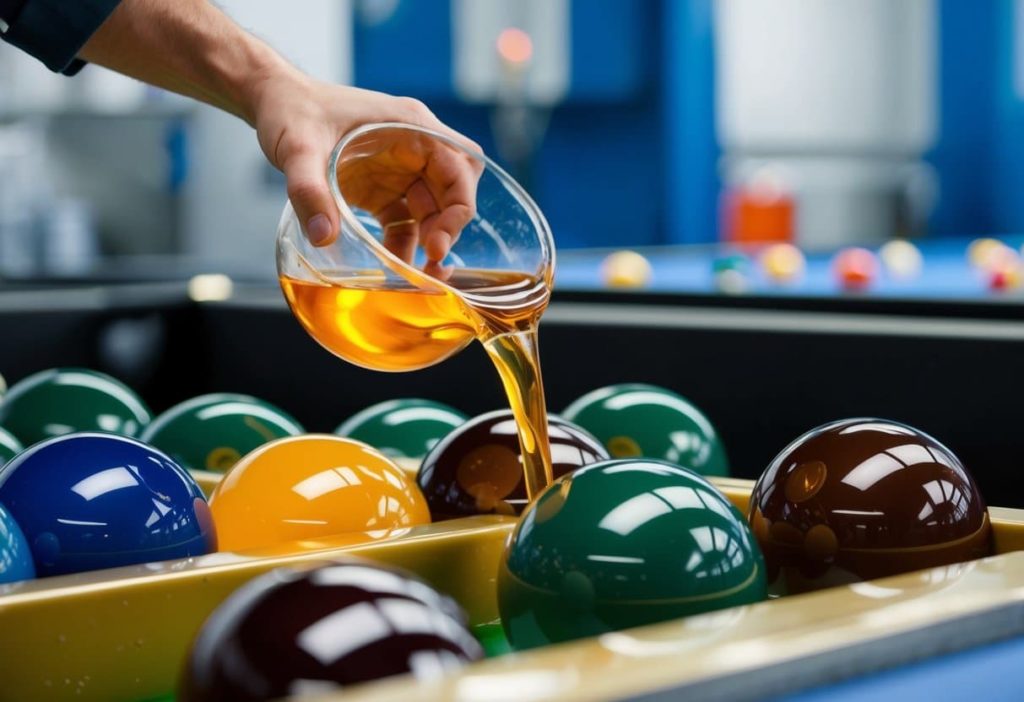
Billiard ball production involves precise techniques to create high-quality spheres. Manufacturers use specialized methods to ensure balls meet strict standards for size, weight, and finish.
Casting and Molding Techniques
The process starts with phenolic resin or polyester. Workers heat the material until it melts. They pour the liquid into metal moulds shaped like spheres. The moulds have two halves that fit tightly together.
As the resin cools, it hardens into a rough ball shape. After cooling, machines remove the balls from the moulds. At this stage, the balls are not yet perfect spheres.
Precision and Tolerances
Makers grind the balls to exact sizes. They use special machines with very fine abrasives. These machines remove tiny amounts of material from the surface.
The goal is to create balls within 0.127 mm of the target diameter. This tight tolerance ensures fair play. Balls also must weigh between 156 and 170 grams.
Careful testing checks each ball. Any that don’t meet the standards are rejected.
Polishing and Finishing
The final step is polishing. Machines use progressively finer abrasives to smooth the surface. This creates a glossy finish.
Workers inspect each ball by hand. They look for tiny flaws or marks. Only perfect balls pass this check.
Lastly, machines add numbers and logos to the balls. They use special inks that won’t chip or fade during play.
Physical Properties and Performance
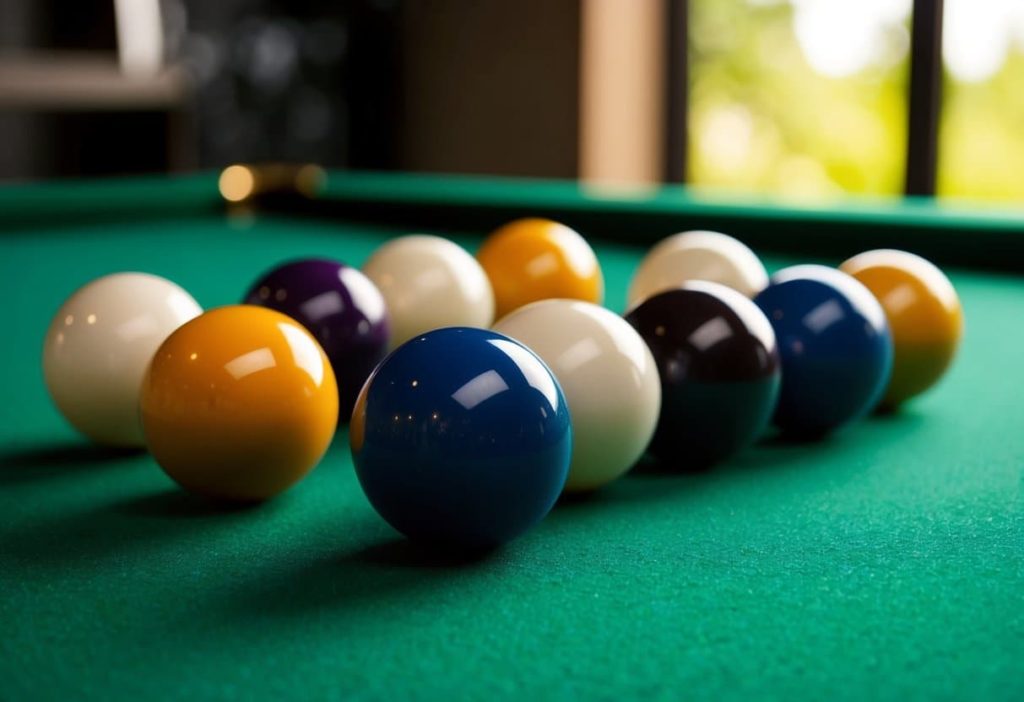
Billiard balls have unique physical traits that affect how they behave on the table. These properties are key to the game’s precision and enjoyment.
Density and Weight
Billiard balls are dense and heavy for their size. A standard ball weighs between 156 and 170 grams. This weight gives them momentum when struck. The density is uniform throughout the ball. This ensures they roll smoothly and predictably.
Different ball sets may vary slightly in weight. But all balls in a set must be within 0.5 grams of each other. This tight range keeps play fair and consistent.
The material used affects density. Phenolic resin, a common choice, has a density close to that of ivory. This helps maintain traditional playing characteristics.
Hardness and Resilience
Billiard balls are very hard. This hardness helps them keep their shape and size over time. It also affects how they react when hit.
The hardness is measured on the Rockwell R scale. Most balls rate between 85 and 100. This high rating means they won’t dent or scratch easily.
Resilience refers to how well the balls bounce back after impact. High-quality balls have good resilience. They transfer energy well between balls and maintain their bounce over many games.
Impact Resistance and Durability
Billiard balls face constant impacts. They must withstand these forces without chipping or cracking.
Modern balls are made to last for thousands of games. They resist damage from cue strikes and collisions with other balls.
The outer layer of a ball is often tougher than its core. This protects against surface damage while keeping the ball’s overall properties intact.
Regular cleaning and care can extend a ball’s life. But even with good care, pros may replace balls after a few years of heavy use.
Balance and Roll
A billiard ball must be perfectly round and balanced. Any flaw in shape can cause it to roll off course.
The balance of a ball is checked by floating it in a salt solution. A well-made ball will not favour any side as it floats.
The surface finish of a ball affects its roll. A smooth surface reduces friction with the tablecloth. This allows for more predictable movement.
The coefficient of friction between the ball and the cloth is crucial. It’s typically around 0.2, allowing for controlled rolls and spins.
Environmental and Ethical Considerations
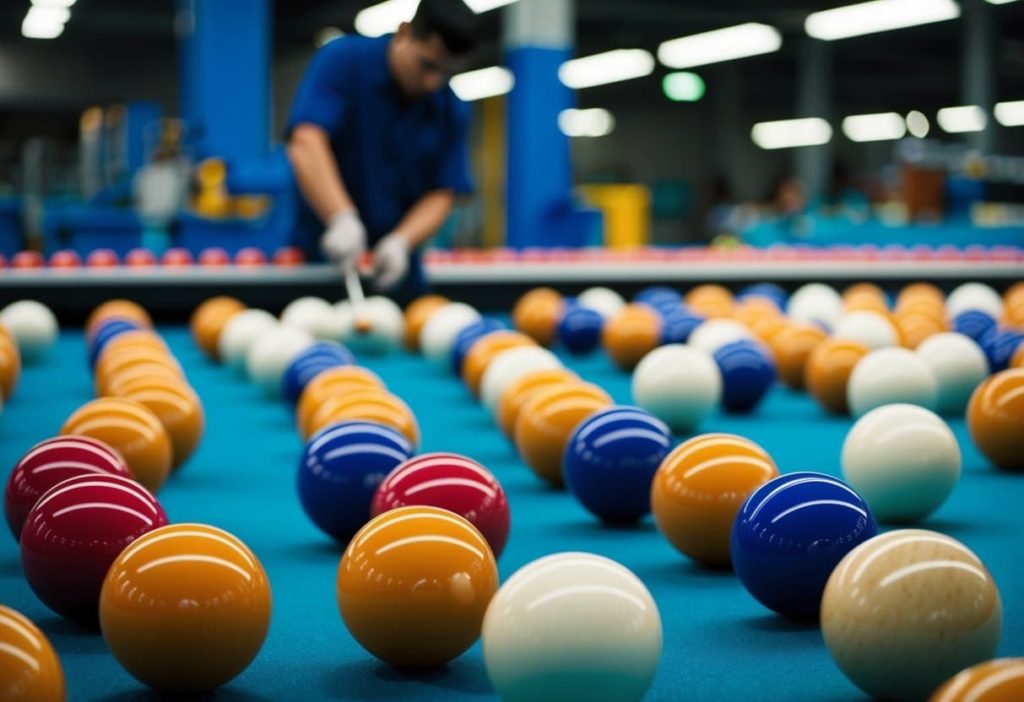
Billiard balls have a complex history when it comes to their materials. In the past, ivory was the top choice for making these balls. This led to serious ethical issues.
Elephants were hunted for their tusks to produce ivory billiard balls. This practice put elephant populations at risk. It also raised concerns about animal welfare and conservation.
The shift away from ivory was a big win for elephants. Synthetic materials took over as the main ingredient for billiard balls. This change helped protect elephants and their habitats.
Today’s billiard balls are often made from plastic resins. These materials are more eco-friendly than ivory. They don’t require harming animals to produce.
Still, plastic has its environmental drawbacks. It can take a long time to break down in landfills. Some companies are looking into more sustainable options for the future.
The move to synthetic materials shows how product design can affect wildlife. It’s a good example of how changing manufacturing can help solve ethical problems.
Gameplay Experience and Maintenance
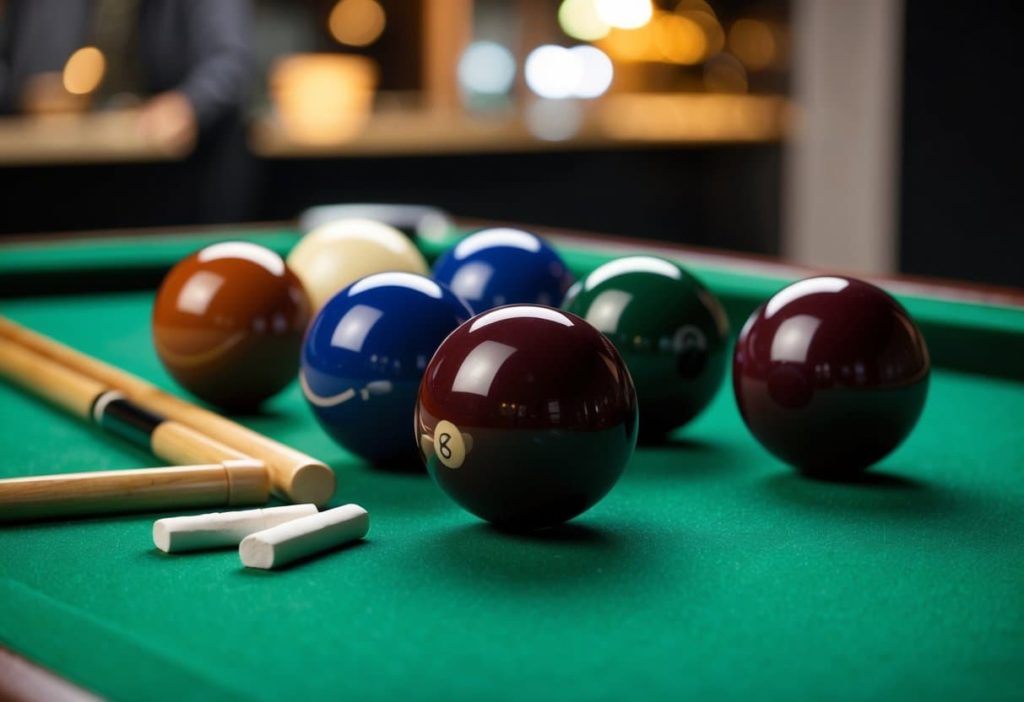
The materials used in billiard balls impact how they behave on the table and how long they last. Players need to understand these factors to get the most out of their game.
Influence on Spin and Speed
Phenolic resin balls offer excellent spin control. Their slightly textured surface grips the cue tip well. This allows players to apply English and create curved shots more easily. The density of phenolic resin also helps maintain ball speed after impact.
Polyester balls have a smoother surface. This can make it trickier to add spin, but they roll very true. Their lighter weight means they can travel faster initially but may slow down more quickly.
The cue ball often uses a different material than the other balls. This impacts how it reacts to shots and affects gameplay strategy.
Consistency and Playability
High-quality billiard balls maintain their shape and weight over time. This keeps gameplay fair and predictable. Aramith balls are known for their consistency. They stay round even after thousands of impacts.
Cheaper balls may become unbalanced with use. This leads to unpredictable rolls and bounces. Pros and serious players prefer balls that perform the same way every time.
Temperature can affect how balls behave. Some materials expand or contract more than others as temperatures change. The best balls stay consistent in different conditions.
Cleanliness and Longevity
Regular cleaning keeps billiard balls in top shape. A soft cloth removes chalk dust and oils from hands. This helps the balls roll smoothly and prevents staining of the cloth.
Harsh chemicals can damage ball surfaces. Mild soap and water is often enough for routine cleaning. Special billiard ball cleaners are also available.
Proper storage protects balls when not in use. A case or rack keeps them from getting scratched or chipped. Extreme heat or cold should be avoided to prevent material stress.
With good care, quality billiard balls can last for many years. Some players even pass down well-maintained sets through generations.
Regulations and Standards
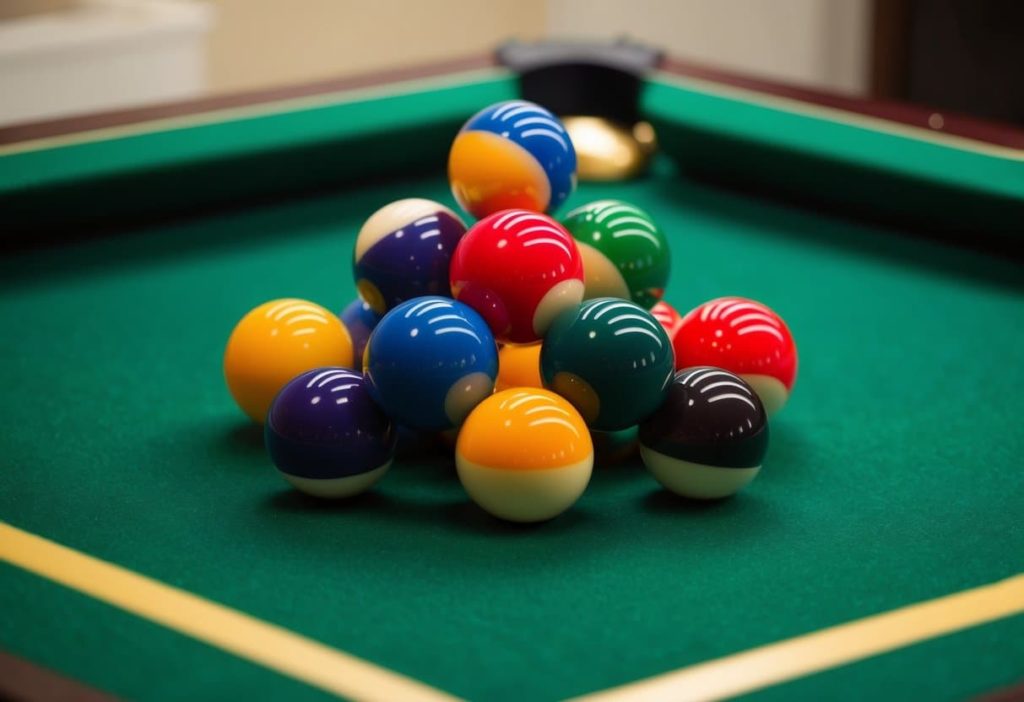
The World Pool-Billiard Association (WPA) sets the rules for billiard balls in cue sports. These rules cover games like eight-ball, nine-ball, and blackball.
WPA specs say billiard balls must be:
- 57.15 mm (2 1/4 inches) in diameter
- Between 156 and 170 grams in weight
- Made of phenolic resin or other approved materials
Balls need to be perfectly round. They can’t have any dents or scratches. The numbers and stripes on the balls must be clear and easy to see.
For snooker, different rules apply. Snooker balls are smaller than pool balls. They measure 52.5 mm in diameter and weigh about 142 grams.
Many tournaments use Aramith balls. These meet all WPA standards. Some players prefer them for their durability and consistent play.
Local leagues might have their own rules. But most follow WPA guidelines. This helps keep the game fair for everyone.
Frequently Asked Questions
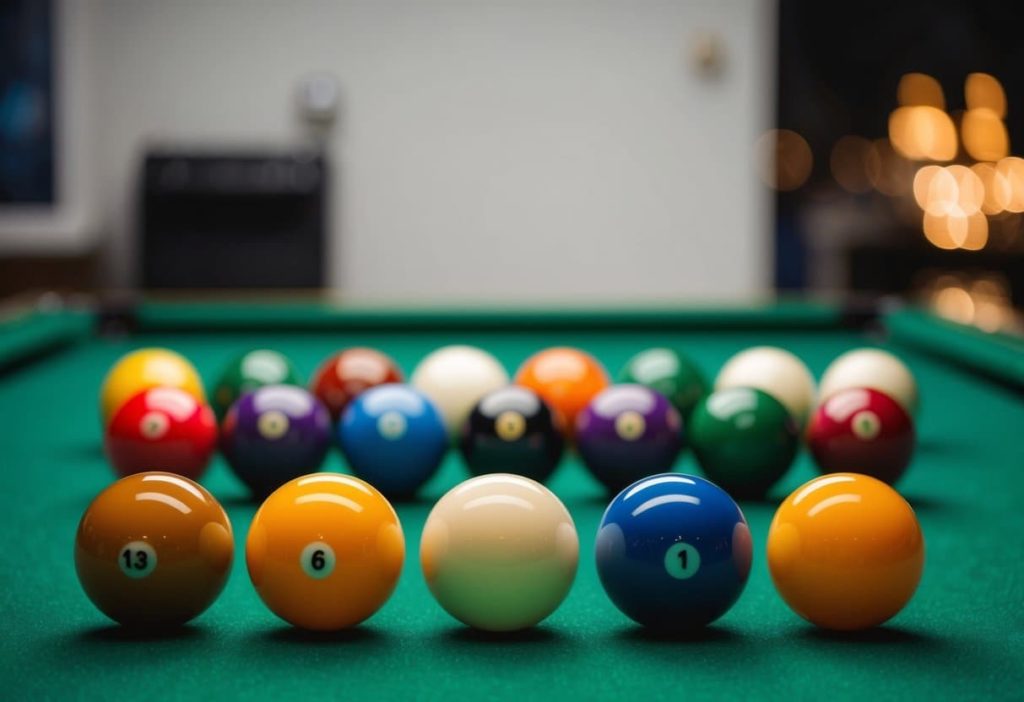
Billiard balls have changed a lot over time. Different materials have been used to make them. Let’s look at some common questions about billiard ball materials.
What materials were originally used to manufacture billiard balls?
The first billiard balls were made of wood. Later, ivory became the top choice. Ivory balls were prized for their smoothness and weight. But ivory was expensive and hard to get.
What substances are contemporary billiard balls typically composed of?
Today, most billiard balls are made of phenolic resin. This is a type of plastic. It’s strong and can be made to look like ivory. Some cheaper balls are made of polyester resin.
How do the compositions of premium billiard balls differ from less expensive ones?
Premium balls often use better phenolic resin. They have more precise size and weight. Cheap balls might use polyester or lower-grade phenolic resin. They may not be as round or balanced.
What impact did the introduction of synthetic materials have on the production of billiard balls?
Synthetic materials changed everything. They made balls cheaper to produce. The new balls were more uniform in size and weight. This led to better play. It also helped protect elephants by reducing ivory use.
Can you elaborate on the differences between standard pool balls and Aramith balls?
Aramith balls are top-quality phenolic resin balls. They’re known for being very round and having perfect balance. Standard balls might not be as precise. Aramith balls also tend to last longer and keep their shine better.
How have the materials used for billiard balls evolved over the last century?
A century ago, ivory was still used for high-end balls. In the early 1900s, makers started using celluloid. By the mid-1900s, phenolic resin took over. The move to synthetics made balls more affordable and consistent.
What Types of Billiard Balls Can You Buy?
You can play an assortment of games on your billiards table with different balls and rules. The colour and diameter change most often, though some games call for different weights. The hardness (density) and polish (friction) affect playability, too. These properties can alter accuracy, reflectivity, and rolling distance.
The material of the ball also impacts gameplay. Most commonly, billiards balls are made of phenolic resin or a similar plastic. That said, some sets are made from wood, clay, and ivory.
American 8-Ball Pool Set
Balls in this set measure 2 ¼ inches in diameter. They come in two numbered suits—solids and stripes. There are 15 object balls in total (cue ball excluded). The weight of each ball depends on its material, though the standard range is between 5 ½ and 6 ounces.
Snooker Ball Set
Snooker involves one cue ball, 15 red balls, and 6 object balls. The object balls include the following colours: yellow, green, brown, blue, pink, and black. Each ball is approximately 2 1⁄8 inches in diameter.
Carom Billiards Balls
Carom billiards sets come with the fewest balls. In fact, carom tables do not even have pockets! There are three balls in total: one yellow, one red, and one white. Each is 2 7/16 inches in diameter.
British-Style Blackball
This English variant comes with seven yellow and seven red balls, each 2 1/8 inches in diameter. Balls in this set are unnumbered besides the 8-ball (the black ball).
Training Balls
Many manufacturers sell balls not intended for real gameplay. These come in different sizes, colours, and weights, depending on their purpose. For example, some cue balls have rings as targets for new players. Different rings produce unique shots like the backspin or “English”.

